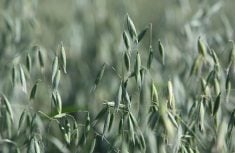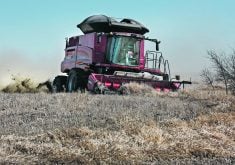MEDICINE HAT, Alta. – Successfully growing native grasses requires patience for the slow growing plants, but the long-term benefits on grazing land are tangible.
A research project starting in 2001 at Swift Current, Sask., involved planting different mixtures of native grass species. The study is assessing the benefits of soil carbon storage, extending the grazing season, creation of biodiversity and nutrition for livestock.
“We can design these mixtures now that will have some sustainability and extend those grazing seasons longer,” said Alan Iwaasa, ruminant grazing specialist at Agriculture Canada’s Swift Current research centre. He described the ongoing project at the Southern Alberta Conservation Association meeting in Medicine Hat Dec. 2.
Read Also

VIDEO: Ag in Motion documentary launches second season
The second season of the the Western Producer’s documentary series about Ag in Motion launched Oct. 8.
The grasses were planted directly into stubble with an air drill in 2001, the driest year on record for the area where annual precipitation is less than 360 millimetres. A phosphate fertilizer of 11-51-0 was included with the seed mix.
Successful planting means good planning by using seeds that are native to the area, proper weed control and timely rains.
“If you have a lot of weeds, the native species can be outcompeted,” Iwaasa said.
Some plants did not germinate the first spring because of drought but production improved by 2003, which was a wet year.
“What is so incredible about natives is their ability to hold on,” he said.
One pasture was seeded to a simple mix of six wheat grasses and a legume. Another was planted with 14 grasses along with two different shrubs. The seed mixes had Canadian wild rye grass, needle and thread grass, June grass, prairie sandreed as well as other cool and warm season grasses that grow at different rates and extend the grazing season.
In nature, a native pasture could have 200 different plants compared to the research program of selected grasses and forbs.
Once established, native plants require less labour and live for a long time compared to tame grasses that may not last five years. These species can go into marginal land to complement existing grazing systems on tame pastures.
After the plots were established, researchers measured the average daily gain among the cattle grazing the plots. The more complex the plant diversity, the greater the weight gain, especially if there were growing green plants throughout the season. If plants are highly digestible, the animals will eat more.
“It comes down to the individual animal selecting what it wants to eat,” Iwaasa said.
Southwestern Saskatchewan and southern Alberta are considered semi-arid regions, so native plants are a good choice.
“Native plants have various strategies that can protect their water resources,” he said. Some can green up with as little as five mm of moisture.
They also hold their nutritional qualities better than tame forages.
“If we have a pasture that can weather some of these environmental situations it is a benefit,” Iwaasa said.
Researchers also know these stands can store half a tonne of carbon per acre because most of the plant is below ground with a large root system. Because these are long-lived, the sequestration goes on for years.
Overall, native grasses and forbs can be productive. They make good livestock feed and improve soil conservation and fertility. Native species’ root systems occupy a huge underground area and form a network that holds the soil in place. Every year 20 to 50 percent of this mass, as well as the top growth in temperate climates, dies and becomes organic matter.
One of the limitations to using natives is the seed can be hard to find and it is more expensive than tame grasses. However, the stand will last more than 20 years compared to tame grasses that are exhausted in less than five years.















